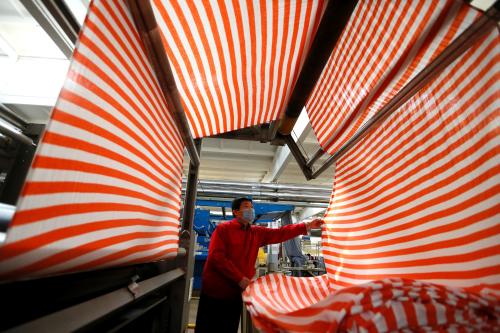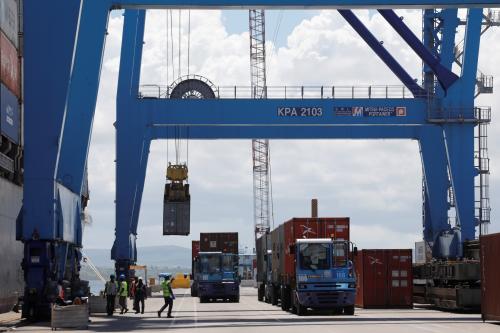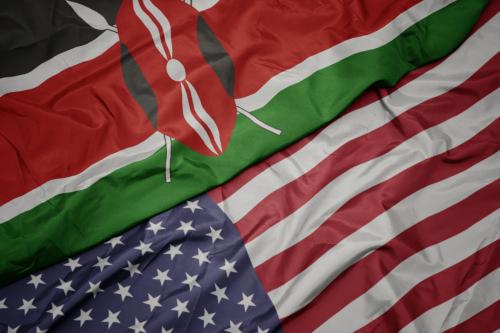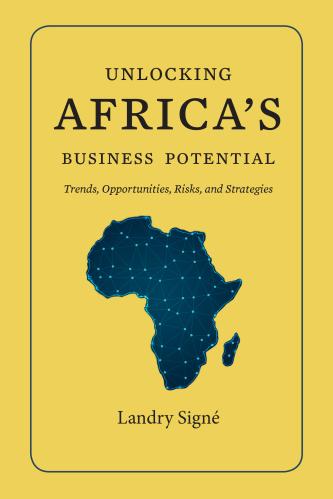The conventional wisdom is that the difference between regional integration in Southeast Asia and that in sub-Saharan Africa is that while the former is driven by markets and concrete economic initiatives, the latter relies on a politically driven process with big talks by big men at big summits generating tiny results. A closer look reveals that this isn’t actually true: Attributing ASEAN success solely to market forces is misleading. Getting the facts right could greatly help other regions around the world improve their integration initiatives.
The first crucial fact is the pivotal role of Japan in the establishment of regional production networks in Southeast Asia by promoting regional trade. Japan followed through on the “Flying Geese” paradigm developed in the 1930s by implementing it meticulously after the Second World War. The other uniquely Asian characteristic is the role of family conglomerates, especially of Chinese origin. African leaders can learn a lot by understanding how these two characteristics shaped economic and political integration in Southeast Asia. It might help them transmute a noisy but sluggish politically driven process into a quietly dynamic, private-sector-led regional integration.
Lesson 1: Theorize, then meticulously implement
The Association of South and East Asian Nations (ASEAN) is more than 50 years old. It was formed on August 8, 1967, in Bangkok, Thailand. The founding members were Indonesia, Malaysia, the Philippines, Singapore, and Thailand. Over time, it grew to include Brunei Darussalam in 1984, Vietnam in 1995, Laos and Myanmar in 1997, and Cambodia in 1999. Today, these countries form the 10 member states of ASEAN.
In 1937, long before the region became the economic success story we admire today, Kaname Akamatsu, a Japanese scholar, developed the Flying Geese paradigm theorizing on how technological development could be promoted in Southeast Asia from Japan as a leading regional anchor. Kiyoshi Kojima, a proponent of the paradigm, argued in the 1970s that in the presence of scale economies, countries could gain from specialization even when they had similar technological levels and factor endowments. He developed a simple model in which two identical countries could produce two goods under conditions of perfect competition and identical external economies of scale. Welfare would be higher if the countries integrate (“coordinate”) and each specializes in one of the goods instead of producing both. Kojima proposed that regional agreements could help facilitate technology transfers and productivity growth following the Flying Geese paradigm. Trade integration would in turn further strengthen cooperation as it reduces rivalry in product markets, setting in train a virtuous cycle.
Japanese theorists also conceptualized the linkages among various overseas activities of Japanese transnational corporations through subcontracting, licensing arrangement, joint ventures, and foreign direct investment with the theme of regional integration in East Asia. Their ideas helped both policymakers and the private sector map out an implementable regional integration plan. They foresaw that packaged real and financial asset flows from Japan to follower economies would augment the benefit of inter-economy linkages—both for Japan and for ASEAN countries. Foreign direct investment, which began to grow in the 1970s and dramatically accelerated after the mid-1980s, facilitated Japan’s economic restructuring—scaling down industrial sectors that were losing competitiveness and releasing resources for the sectors gaining competitiveness—while simultaneously aiding the structural transformation of many ASEAN countries.
Lesson 2: Build on your strengths, then remedy your shortcomings
The second thing Africa can learn from the private-sector-led regional integration in ASEAN is about the central role of family businesses. Large, diversified, family-owned businesses are indeed dominant players in ASEAN+3 (the ASEAN 10 plus China, Japan, and Korea). The family is the basic unit of management, making possible speedy decisions, and providing loyalty, flexibility, and low overheads. It also breeds trust, a crucial business element in all circumstances but especially in settings where governance is weak.
Ronald Coase’s conceptualization of the nature of the firm—coincidently published in 1937—as an arrangement to reduce organizational costs is consistent with this view. When Henry Sy, the most successful Chinese entrepreneur in the Philippines, invited his children and grandchildren for Sunday lunch, six of his company executives would show up, allowing for a discussion of plans and finances in a convivial and confidential family gathering. The Charoen Pokphand (CP) Group, Thailand’s largest conglomerate whose wealth is estimated at more than $5 billion, began as a small farm-seed company founded by a Chinese merchant who had moved to Bangkok. The company grew into a conglomerate as it expanded the market for its seed. CP now controls more than 200 companies in Thailand, Indonesia, Taiwan, Turkey, Portugal, and the Philippines. Many Western companies that later moved successfully into mainland China—such as Motorola, Coca-Cola, KFC, Lockheed, Chrysler, and Procter & Gamble—have done so by forming joint ventures with members of Chinese family conglomerates.
To be sure, such arrangements can have drawbacks. The industrial titans of the Gilded Age in the United States were largely family businesses, and the economy they built was one of the most unequal in recent times. Today, in most developed nations, the largest industry-leading companies are typically held by a broad, dispersed mix of shareholders; e.g., fewer than a third of the companies in the S&P 500 remain founder- and family-owned businesses. But as brisk growth propels emerging economies forward, a 2014 McKinsey article suggests that by 2025, family conglomerates will represent nearly 40 percent of the world’s large enterprises, up from roughly 15 percent in 2010 (Figure 1). Southeast Asia will be leading the pack; Africa will be bringing up the rear. This is something about which Africa’s leaders should think, and African economists theorize.
Figure 1. Family-owned businesses around the world, 2010-2025
Source: McKinsey & Company
Flying Geese and family conglomerates in Africa?
The Flying Geese paradigm emphasizes the role of an advanced external partner (originally Japan) in the emergence and success of business-led regional integration in Southeast Asia. In 2000, the United States launched the African Growth and Opportunity Act (AGOA) while a year later, the European Union instituted the Everything But Arms (EBA) preference focusing on all least developed economies. Because of the sheer size of these markets, there were high expectations of the impact on trade and growth. With the rise of Asia as a major global market, exploring export opportunities in ASEAN+3 seems to be a sound move, allowing the various African regional economic communities to choose from three additional potential partners.
Developing an understanding of family conglomerates is crucial for global companies active in emerging markets, but also for would-be investors. A private-sector-led regional integration in sub-Saharan Africa could benefit by learning from ASEAN+3 family conglomerates’ role in the emergence of regional production networks.
A universally acknowledged strength of the integration process in Africa is that it has the attention of heads of state through the African Union platform. African policymakers might need to rely on two ASEAN-specific characteristics to “transmute” this strength into a private-sector-led regional integration: 1) understanding the role of family conglomerates and 2) transforming economic relations with former colonial powers and new global leaders into better business and more innovation.
African leaders like to think big; we propose that they enlist African big business people such as Aliko Dangote, Baba Danpullo, and Nicky Oppenheimer in the regional integration effort. A good way to start might be to convene a “friends of ASEAN-AFRICA trade and investment diversification” group by mobilizing big business figures and trusted high-level policymakers in ASEAN and Africa. The group could help to find ways to get African economies to join the Flying Geese—by identifying strategic anchors and promoting the collaboration of family conglomerates in the two regions. The World Bank Group’s Kuala Lumpur “Inclusive Growth and Sustainable Finance” Hub has been working to support such relationships.
This blog post reflects the personal views of the author and does not represent the position of the World Bank Group.
The Brookings Institution is committed to quality, independence, and impact.
We are supported by a diverse array of funders. In line with our values and policies, each Brookings publication represents the sole views of its author(s).









Commentary
Two lessons from ASEAN for regional integration in Africa
July 29, 2020